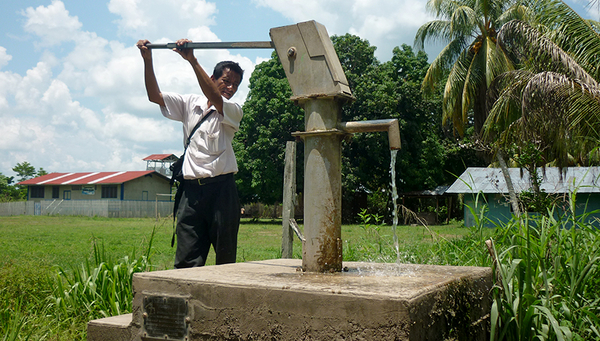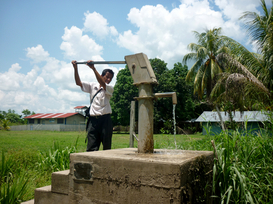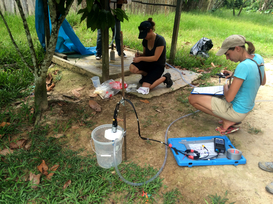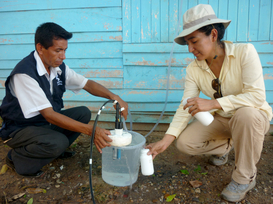News Detail
Arsenic and manganese contamination in Amazonia groundwater
April 10, 2018 |
Even in the remotest areas of the world, reality can be harsh. Many people living along the Amazon have to tap groundwater resources, as the river water is too polluted to drink. Turbidity (due to sediment loads) and fluctuations in discharge are additional obstacles to direct use of river water. It has now been shown that even the groundwater is not necessarily safe: in many cases, water pumped from wells is contaminated with arsenic, manganese and aluminium. These trace elements are released from sedimentary deposits in the subsurface and are thus “geogenic” (i.e. they do not derive from industrial pollution).
An Eawag team led by geologist Caroline de Meyer, together with researchers from Peru and Brazil, has now for the first time systematically collected groundwater samples from over 250 sites along the Amazon and analysed them for the most important trace elements. The results, combined with existing data on geology, river morphology and land cover, enabled the scientists to identify areas where arsenic contamination is particularly serious. In the medium term, the settlements or towns affected will need to find alternative ways of ensuring safe water supplies.
Limited awareness
According to de Meyer, awareness of the problem is widely lacking. Fortunately, water contaminated with arsenic often also contains high concentrations of iron. When it is pumped to the surface, the iron is oxidized and the water turns reddish-brown: “For this reason, people often let it stand for a while,” says de Meyer. The iron oxide – with some of the arsenic bound to the particles – then settles out. However, manganese and aluminium generally remain in the water. While limits have been established for arsenic (the WHO guideline value is 10 μg/L), the health-based values for manganese and aluminium are subject to debate. Studies have indicated that exposure to concentrations of manganese in water above 400 μg/L may lead to neurotoxicity, especially in young children. The highest levels detected by de Meyers’ team are 6 mg/L – 15 times over this limit. Aluminium concentrations were up to three times higher than the level considered safe.
Growing numbers believed to be affected
The scientists cannot yet say how many people in underdeveloped regions of Amazonia are affected by arsenic and manganese contamination. An initial study on the analysis of groundwater in Peru has been published*; further samples are now being investigated, including water from wells in Amazonas, a state of northwestern Brazil. The scientists’ work is being presented today at the 2018 General Assembly of the European Geosciences Union (EGU), held in Vienna. Even before comprehensive data are available, De Meyer warns: “There is a dearth of hydrogeological studies along the Amazon, but our analyses show that, wherever groundwater is pumped, arsenic, aluminium and manganese contamination should not be underestimated – all our data point in the same direction.”
A typical groundwater well and scientists measuring geochemical parameters in Peru. (Photos: Caroline de Meyer, Eawag and Edward Carpío Deza, Universidad Nacional de Ingeniería, Lima).
Study on the analysis of groundwater in Peru
De Meyer, C. M. C., Rodríguez, J. M., Carpio, E. A., García, P. A., Stengel, C., & Berg, M. (2017). Arsenic, manganese and aluminum contamination in groundwater resources of Western Amazonia (Peru). Science of the Total Environment, 607-608, 1437-1450.
http://doi.org/10.1016/j.scitotenv.2017.07.059
The study was financially supported by the Swiss National Science Foundation (grant no. 165913) and the EPFL Cooperation & Development Center (CODEV).
EGU press conference no. 3 (13:00–14:00 on 10 April 2018) will be live-streamed at: https://client.cntv.at/egu2018/pc3




